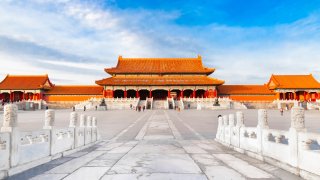Is “The Chinese World” the Future? Confucianism and Xi Jinping
To better understand Xi’s grand ambition and vision for a Chinese international order, it is necessary to better understand its philosophical underpinnings.
It was the Opium Wars that changed the Chinese hierarchical system into one of direct colonialism until the end of World War II, while gradually extending Western ideas to East Asia. During the Cultural Revolution, Confucian doctrine suffered greatly, as Maoism became the new ideology of China. But after the death of Mao Zedong, the CCP’s Five Disciplines, Four Graces and Three Loves policy began the process to (re)civilize China and consolidate the legitimacy of the Chinese Communist Party. Once again the doctrine of filial piety would promote obedience and regulate relations, and thus re-establishing the precedent for Xi’s “Chinese Dream.”
How the CCP Draws from Confucianism
From its foundation in 1921, the Chinese Communist Party’s (CCP) concern has been to seek legitimacy in order to transform China. With the introduction of the “socialist market economy,” the CCP aimed to achieve this by improving China’s average standard of living. When Xi became the secretary general of the Party, he invoked the Confucian thinker Liu Xiang to underline the connection between power and the needs of the people.
While the West tends to be critical of the current Chinese one-party state as illegitimate, for a vast number of Chinese people it is not abnormal. For over two thousand years, China has been ruled by a unified Confucian elite through an imperial examination system designed to provide proportional representation in tianxia. The one-party state resembles more the Chinese tradition of a meritocracy than the ideal of Western democracy. The Chinese imperial examination system, known as keju, was not only meant to recruit talented people to administer the state, but also to counterbalance the power of the military and the sovereign. This system led to social mobility, along with political and social stability, especially as the number of officials was proportional to the population of each province. The keju was the standard model for an ethical man to prove his virtues, with the hope of becoming a bureaucrat. Today, Chinese parents place an important focus on the education of their children, and the influence of the Chinese education model is reflected by the high performance of Korean, Japanese, and Vietnamese students. The keju’s descendants in modern-day China, the gaokao for entrance to university and the examination for the civil service, are possibly the least corrupt institutions in the state; allowing access to leadership to all social classes and assisting to legitimize the system.
In addition, China uses history and culture to construct a linear narrative that replaces Western modernity, whose success represents its failure. On occasions, Xi alludes to the Qing dynasty, criticized by both Chinese nationalist and communist historiography. While the Qing dynasty extended control to Taiwan, Mongolia, Tibet, and Xinjiang, it is blamed for China losing control of its economy and ports, due to Western, Russian, and Japanese imperialism. Wang Qishan, known as Xi’s right-hand man, delivered a speech at the New World Economic Forum in Singapore in 2018, where he alluded to 1840, the “hundred years of national humiliation,” and the determination of the millenarian Chinese civilization to retake its place in the world with “Chinese characteristics.” This view of history is ingrained in the ideals of the CCP, whose legitimacy rests on recovering the historical status China once held.
For Xi, Chinese identity goes beyond nationalist and territorial borders and intentions. Xi views the “Chinese blood” of the millions of huaqiao (Chinese citizens residing abroad) and huaren (ethnic Chinese abroad) part of the “great Chinese family”—essential in bolstering the revitalization of the “Chinese Dream.” This dream portrays the “harmony” experienced during China’s dynastic history to convince the region of the benefits of a Pax Sinica in Asia. In fact, during the 19th National Congress, Xi explained that the “Chinese Dream” was meant to be shared by the rest of the international community. Yet while it tries to show its ascent to power is benign, China hides that it is a revisionist power, fermenting authoritarianism abroad and exporting its model for economic development. And it understands that to change the system, it must do so from the periphery, which will allow it to transform Western hegemony.
Back in 2005, China, under then-president Hu Jintao, unveiled the concept of a “harmonious world.” That same year, Chinese philosopher Gan Yang delivered a lecture in Beijing in which he advocated unifying Confucianism, Maoism, and Xiapoing’s reforms, while the philosopher Zhao Tingyang initiated the debate over the concept of tianxia and its application to our contemporary world—the system that allowed dynastic China to harmoniously rule over its local tributaries could thus be expended outwards. The CCP and Chinese intellectuals, in other words, are attempting to justify their own power and present a benevolent image of China.
Yet despite Zhao Tingyang’s objections that tianxia holds no “outsiders,” it is clear that the “Chinese center” uses dynamics of exclusion and inclusion to marginalize others like the West or even periphery nations. While Confucian thought supports the use of force only to restore political and moral order, it promotes a paternalistic diplomacy of a tributary character.
For those wondering what a Chinese international order would look like, this is something to keep in mind.
Carlo J.V. Caro is a political and military analyst. He has a graduate degree from Columbia University.
Image: Unsplash.

